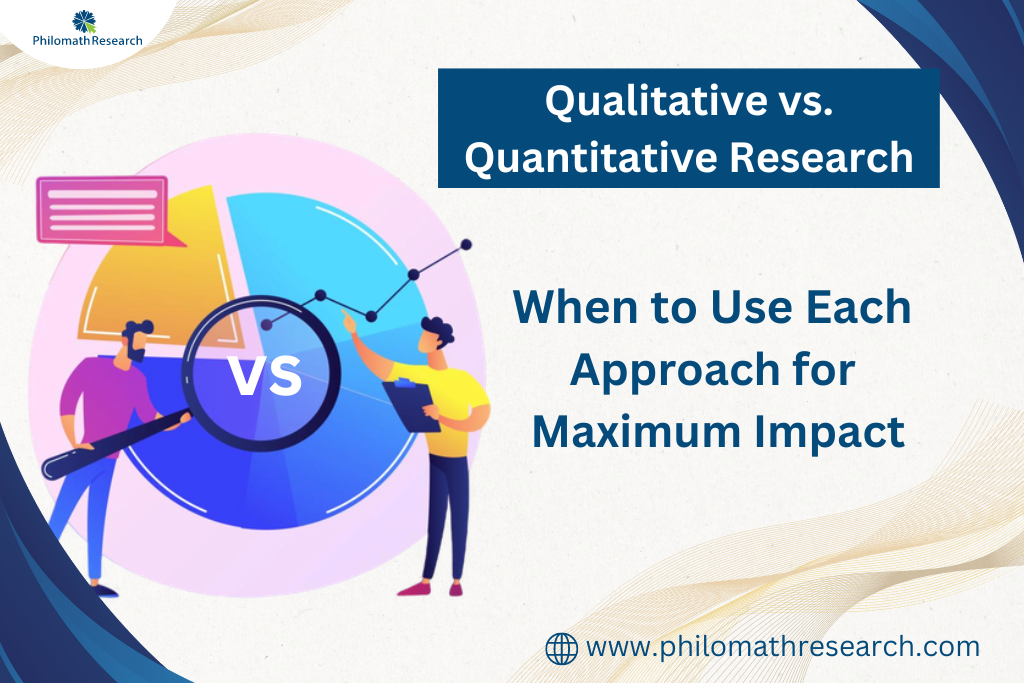
Qualitative vs. Quantitative Research: When to Use Each Approach for Maximum Impact
In the dynamic world of research, two prominent approaches take center stage: qualitative and quantitative research. These methodologies serve as valuable tools for uncovering insights and facilitating informed decision-making, albeit through different lenses. At Philomath Research, we recognize the criticality of selecting the appropriate research approach to maximize impact. In this blog, we delve into the distinct characteristics, strengths, and applications of qualitative and quantitative research methods.
Qualitative research focuses on understanding the depth and complexity of human experiences, behaviors, and perceptions. It involves gathering non-numerical data through techniques such as interviews, focus groups, and observations. By exploring the nuances and context of individuals’ responses, qualitative research strives to generate rich, descriptive insights. This approach is particularly useful for exploring topics that are subjective, sensitive, or require in-depth exploration of human motivations and experiences. It enables researchers to uncover underlying patterns, attitudes, and beliefs that can provide a comprehensive understanding of the research topic.
On the other hand, quantitative research emphasizes numerical data and statistical analysis to derive objective and measurable conclusions. It employs structured surveys, experiments, and other quantifiable methods to collect data from a larger sample size. By analyzing this data using statistical techniques, researchers can identify trends, correlations, and patterns that offer a more generalized understanding of a larger population. Quantitative research provides a basis for making predictions, testing hypotheses, and measuring the impact of variables with a higher degree of precision and statistical validity.
Understanding when and how to leverage each approach effectively is crucial for organizations seeking to harness the power of research. Qualitative research is well-suited for exploratory studies, hypothesis generation, and gaining in-depth insights into complex human behaviors and motivations. It allows businesses to grasp the “why” behind consumer preferences, make informed product design decisions, and develop effective marketing strategies.
On the other hand, quantitative research excels in situations where large-scale data collection and statistical analysis are required. It enables organizations to measure the prevalence of trends, validate hypotheses, assess the impact of interventions, and make data-driven decisions. By quantifying variables and analyzing data using statistical models, businesses can identify significant relationships, segment their target audience, and forecast market trends.
By recognizing the strengths and applications of qualitative and quantitative research, organizations can strategically choose the most appropriate methodology for their specific research goals. Combining the insights gained from both approaches can lead to a comprehensive understanding of complex phenomena and inform well-rounded decision-making.
In this blog, we will dive deeper into the characteristics, data collection methods, analysis techniques, and real-world applications of qualitative and quantitative research. By equipping yourself with a robust understanding of these research approaches, you will be better equipped to navigate the ever-evolving landscape of evidence-based decision-making. Stay tuned for insights that will empower your organization’s research endeavours and pave the way for success.
1. Understanding Qualitative Research:
Qualitative research focuses on understanding and interpreting subjective experiences, meanings, and motivations. It emphasizes in-depth exploration and rich contextual understanding. We will delve into the characteristics of qualitative research, including data collection methods such as interviews, focus groups, and observations. We will also highlight the benefits and limitations of qualitative research and its application in various industries.
2. Exploring Quantitative Research:
Quantitative research, on the other hand, deals with numerical data and statistical analysis. It seeks to measure, quantify, and establish patterns and relationships. We will explore the key elements of quantitative research, including survey methods, experiments, and statistical analysis techniques. Understanding the strengths and limitations of quantitative research will help businesses leverage their potential in making data-driven decisions.
3. Identifying the Suitable Research Approach:
Choosing the right research approach depends on various factors. We will discuss the importance of defining research objectives, considering research questions, and understanding the target audience. By aligning research goals with the specific needs of a project, businesses can determine whether qualitative or quantitative research is more appropriate. We will provide practical guidance on selecting the suitable approach to achieve maximum impact.
4. Applications of Qualitative Research:
Qualitative research has a wide range of applications across industries. We will explore how it can uncover consumer preferences, behaviors, and attitudes, leading to the development of tailored marketing strategies, product enhancements, and improved customer experiences. We will showcase real-world examples where qualitative research has been instrumental in generating valuable insights and driving business success.
5. Applications of Quantitative Research:
Quantitative research is invaluable for measuring market trends, customer satisfaction, and performance metrics. We will discuss how quantitative research enables businesses to make data-driven decisions, conduct market segmentation, and analyze large datasets. We will showcase how quantitative research has been utilized to optimize pricing strategies, forecast market demand, and evaluate the effectiveness of marketing campaigns.
6. Combining Qualitative and Quantitative Research:
While qualitative and quantitative research are often seen as distinct approaches, they can also complement each other. We will explore how businesses can leverage mixed-method research, combining qualitative and quantitative approaches for a more comprehensive understanding of a research problem. We will highlight examples where this integration has led to powerful insights and strategic recommendations.
Conclusion:
Qualitative and quantitative research each offer unique benefits and plays important roles in the research landscape. By understanding their characteristics, strengths, and appropriate applications, businesses can make informed decisions and drive impactful outcomes. At Philomath Research, we recognize the value of both qualitative and quantitative research and work closely with our clients to determine the most suitable approach for their specific needs. By harnessing the power of research, businesses can gain valuable insights, enhance their competitive advantage, and achieve their goals. Trust Philomath Research as your partner in conducting high-quality research that maximizes impact and drives success.
Contact us today at www.philomathresearch.com to discover how our expertise in qualitative and quantitative research can support your organization’s growth and decision-making. Together, let’s unlock the full potential of research for maximum impact.